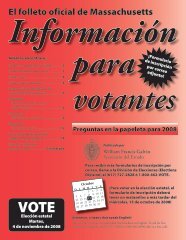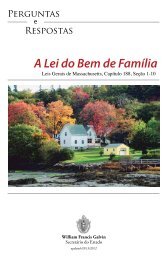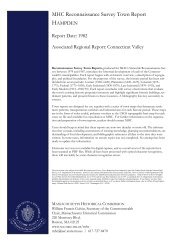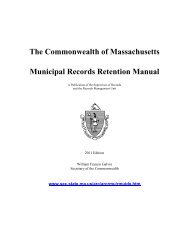CIVIL WAR PROJECT Marie Gibbons Lesson Three: Understanding ...
CIVIL WAR PROJECT Marie Gibbons Lesson Three: Understanding ...
CIVIL WAR PROJECT Marie Gibbons Lesson Three: Understanding ...
You also want an ePaper? Increase the reach of your titles
YUMPU automatically turns print PDFs into web optimized ePapers that Google loves.
<strong>CIVIL</strong> <strong>WAR</strong> <strong>PROJECT</strong><br />
<strong>Marie</strong> <strong>Gibbons</strong><br />
<strong>Lesson</strong> <strong>Three</strong>: <strong>Understanding</strong> the Level of Sacrifice of African Americans in the<br />
Military, Particularly the Massachusetts 54 th , During the Civil War.<br />
This lesson will make use of primary sources from the Massachusetts Archives,<br />
the Massachusetts Historical Society, the National Archives, and a transcript of a letter<br />
sent to the editor of the Boston Journal from a member of the Massachusetts 54 th from<br />
Morris Island, S.C. A book written by a member of the Massachusetts 54 th will also be<br />
utilized in this lesson. These sources will be used as a basis for discussing what, and how<br />
strong, our beliefs and values are, and what we would be willing to sacrifice to promote<br />
and preserve them. Issues such as the professions of the members of the 54 th prior to<br />
enlistment, pay equal to that of white soldiers, safety issues while in Confederate<br />
territory, and others, will be explored using primary sources.<br />
<strong>Lesson</strong> <strong>Three</strong><br />
Goal: To understand the level of sacrifice of African Americans in the military<br />
(particularly the Massachusetts 54 th Regiment) during the Civil War.<br />
History and Social Science Learning Standards Addressed:<br />
Standard One: Chronology and Cause<br />
Standard Two: Historical <strong>Understanding</strong><br />
Standard <strong>Three</strong>: Research, Evidence, and Point of View<br />
Standard Four: Society, Diversity, Commonality, and the Individual<br />
Standard Five: Interdisciplinary Learning: Religion, Ethics, Philosophy and Literature<br />
Standard Sixteen: Authority, Responsibility and Power<br />
Objectives:<br />
• Students will examine the occupations/trades of the members of the<br />
Massachusetts 54 th in the context of economic barriers.<br />
• Students will recognize the level of personal sacrifice Frederick Douglas was<br />
willing to make.<br />
• Students will appreciate the economic hardships African American troops and<br />
their families were willing to endure as a result of their refusal to accept pay<br />
unequal to that of their white counterparts.<br />
• Students will realize the enormous casualties sustained by the Massachusetts 54 th<br />
Regiment at Fort Wagner.<br />
• Students will evaluate the level of danger the Massachusetts 54 th and other<br />
African American regiments placed themselves in when fighting in Confederate<br />
territory, beyond the obvious danger of battle.<br />
• Students will understand William Carney’s courage in preserving and protecting<br />
the flag.
Preparation<br />
Prior to students working with primary source documents students will:<br />
• be made familiar with the social, economic, and political barriers experienced by<br />
African Americans in the North.<br />
• view the video Civil War Journal-The 54 th Massachusetts. This video gives a<br />
history of the 54 th that includes many primary sources.<br />
• examine their own values and beliefs and how much they, or their parents, would<br />
be willing to sacrifice to uphold and safeguard them. Questions that could be<br />
used to help with this examination.<br />
• “What is important to you?”<br />
• “What is important to your parents?’<br />
• “Would you be willing to give up a job that insured your family's financial<br />
security?”<br />
• “Would you be willing to put yourself in danger for an idea or ideal?”<br />
• “Do you think your parents would encourage you to fight for a cause?”<br />
• “How much of a guarantee would you need that your goals would be met<br />
before you put yourself in danger?”<br />
Materials<br />
*Magnifying glasses (to assist in reading of copies of original documents)<br />
*Primary sources:<br />
• roster of Massachusetts 54 th Infantry (found in A Brave Black Regiment-see<br />
bibliography)<br />
• enlistment papers of the sons of Frederick Douglas<br />
• casualty list of the Massachusetts 54 th following the battle at Fort Wagner<br />
• Broadside containing General Order 233 (dealing with protection of African<br />
American troops)<br />
• letter from Confederate colonel (stating Confederate policies toward African<br />
American POWs)<br />
• letter from Union general reiterating the U.S. government’s obligations to African<br />
Americans captured by Confederates<br />
• transcript of a letter to the editor of the Boston Journal from a member of the<br />
Massachusetts 54th<br />
• charges against African American soldier for refusal to accept unequal pay<br />
(Private Ray)<br />
• detachment muster roll of Private Ray’s pay due as a result of the pay<br />
discrepancies between African American and white soldiers<br />
• William Carney’s entries in the Company Description Book of the Massachusetts<br />
54 th<br />
• William Carney’s Medal of Honor notation in the records of the Record and<br />
Pension Office<br />
Time Frame<br />
5 to 7 (40 minute) class periods will be used.
Procedure<br />
Students will be placed in cooperative groups made up of 4-5 students.<br />
Each group will analyze an identical set of documents and manuscripts.<br />
Students will use the 5 W’s to analyze documents (WHO? WHAT? WHERE?<br />
WHEN? WHY?).<br />
They will be instructed to ask, but not limit themselves to the following:<br />
Who created the document? Who is it aimed at?<br />
What issues does the document address?<br />
Where did the document originate? Where was its final destination?<br />
When was the document created? If there is more than one document<br />
dealing with the same subject, when was the first document created? The<br />
last?<br />
Why was the document created?<br />
Evaluation<br />
Acting as a member of the Massachusetts 54 th , each group will use their<br />
information to create a journal tracing major events in the history of the regiment.<br />
or<br />
Groups will role play, assuming the identities of the subjects of the analyzed<br />
documents.
Bibliography<br />
Baker, C. F., Waryncia, L., Silvestro, P., & Dillon, A. (Eds. ). (1999,<br />
January/February). 54 th Massachusetts Volunteer Infantry. Footsteps. New Hampshire:<br />
Cobblestone Publishing Co..<br />
Berlin, I., Reidy, J.P., & Roland, L.S. (Eds. ). (1998). Freedom’s Soldiers: The<br />
Black Military Experience in the Civil War. Cambridge: Cambridge Press.<br />
Press.<br />
Emilio, L.F. (1995). A Brave Black Regiment. New York: Da Capo Press.<br />
Massachusetts Historical Society. (2001). We Fight for Freedom.<br />
O’Connor, T.H. (1997). Civil War Boston. Boston: Northeastern University Press.<br />
McPherson, J.M. (1988). Battle Cry of Freedom. New York: Oxford University<br />
Ripley, C.P., Finkenbine, R.E., Hembree, M.F., &Yacovone, D. (Eds.) (1993).<br />
Witness for Freedom. North Carolina: University of North Carolina Press.<br />
Video<br />
The 54 th Massachusetts. Civil War Journal. (1995). New York: Arts and<br />
Entertainment Home Video.<br />
Web Site<br />
www.nara.gov/education/teaching








